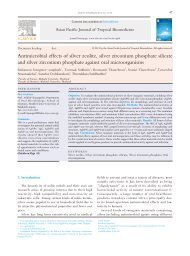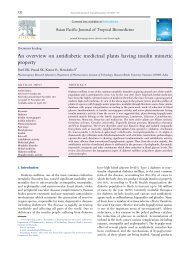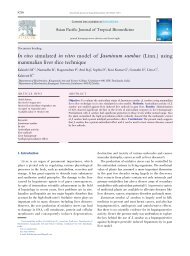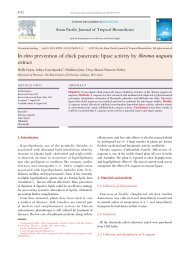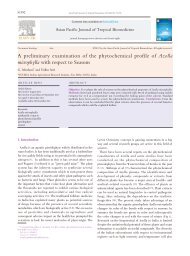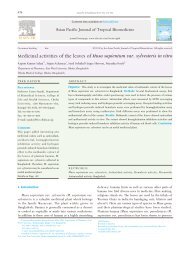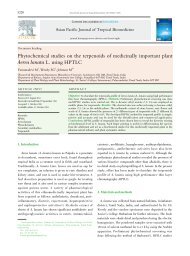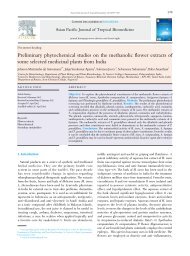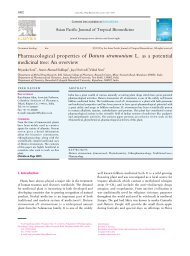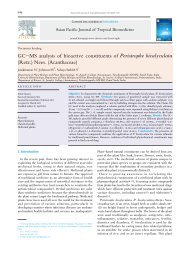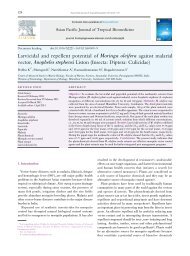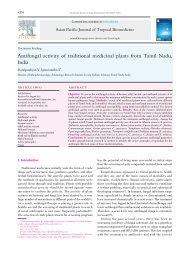Antibacterial activity and physicochemical evaluation of ... - Apjtb.com
Antibacterial activity and physicochemical evaluation of ... - Apjtb.com
Antibacterial activity and physicochemical evaluation of ... - Apjtb.com
You also want an ePaper? Increase the reach of your titles
YUMPU automatically turns print PDFs into web optimized ePapers that Google loves.
Document heading<br />
<strong>Antibacterial</strong> <strong>activity</strong> <strong>and</strong> <strong>physicochemical</strong> <strong>evaluation</strong> <strong>of</strong> roots <strong>of</strong> Butea<br />
monosperma<br />
Prashant Tiwari 1* , Ritesh Jain 1 , Kuldeep Kumar 2 , Rahul Mishra 3 , Anish Ch<strong>and</strong>y 1<br />
1 School <strong>of</strong> Pharmacy, CEC, Bilaspur, (CG), India<br />
2 Smt. Vidyawati Collage <strong>of</strong> Pharmacy, Jhansi, (UP), India<br />
3 Institute <strong>of</strong> Pharmaceutical Sciences, BIT, Mesra, Ranchi, India<br />
ARTICLE INFO ABSTRACT<br />
Article history:<br />
Received 5 June 2012<br />
Received in revised from 5 July 2012<br />
Accepted 7 August 2012<br />
Available online 28 August 2012<br />
Keywords:<br />
Butea monosprema.<br />
<strong>Antibacterial</strong> <strong>activity</strong><br />
Physicochemical <strong>evaluation</strong><br />
1. Introduction<br />
Despite <strong>of</strong> tremendous progress in human medicines,<br />
infectious diseases caused by bacteria, fungi, viruses <strong>and</strong><br />
parasites are still a major threat to public health. There<br />
impact is particularly large in developing countries due<br />
to relative unavailability <strong>of</strong> medicines <strong>and</strong> the emergence<br />
<strong>of</strong> widespread drug resistance[1]. During the last two<br />
decades, the development <strong>of</strong> drug resistance as well as<br />
the appearance <strong>of</strong> undesirable side effects <strong>of</strong> certain<br />
antibiotics[2] has lead to the search <strong>of</strong> new antimicrobial<br />
agents mainly among plant extracts with the goal to discover<br />
new chemical structures, which over<strong>com</strong>e the above<br />
disadvantages[3]. Medicinal plants have been known for their<br />
healing or disease-curing qualities for centuries[4]. Herbal<br />
drugs have gained importance in recent years because <strong>of</strong><br />
their efficacy <strong>and</strong> cost effectiveness. The characteristics <strong>of</strong><br />
the plants that inhibit microorganisms <strong>and</strong> are important for<br />
human health have been researched in laboratories since<br />
1926[5]. Bacterial diseases are a type <strong>of</strong> infectious diseases<br />
caused by pathogenic bacteria. It is notable that majority <strong>of</strong><br />
bacteria are non pathogenic <strong>and</strong> are not harmful to human<br />
health. Some bacteria are even helpful <strong>and</strong> necessary for<br />
*Corresponding author: Prashant Tiwari, School <strong>of</strong> Pharmacy, CEC, Bilaspur, (CG),<br />
India.<br />
E-mail: ptc_ptc15@rediffmail.<strong>com</strong><br />
Grant to Mr. Anish Ch<strong>and</strong> (146/CCOST/2008)<br />
Asian Pacific Journal <strong>of</strong> Tropical Biomedicine (2012)S881-S883<br />
Contents lists available at ScienceDirect<br />
Asian Pacific Journal <strong>of</strong> Tropical Biomedicine<br />
journal homepage:www.elsevier.<strong>com</strong>/locate/apjtb<br />
S881<br />
Objective: To evaluate the antibacterial <strong>activity</strong> <strong>of</strong> the petroleum ether extract <strong>of</strong> root <strong>of</strong> Butea<br />
monosperma (B. monosperma). Method: In vitro antibacterial <strong>activity</strong> <strong>of</strong> petroleum ether i.e.<br />
B. monosperma was studied against Staphylococcus faecalis (S. faecalis), Sterptococcus faecalis<br />
(S. faecalis), Aeromonas hydrophilia (A. hydrophilia), Salmonela typhae (S. typhae), Stphylococcus<br />
cohni (S. cohni), Escherichia coli (E. coli) <strong>and</strong> Serratia ficaria (S. ficaria) by using well diffusion<br />
method. Results: Petroleum ether extract <strong>of</strong> root <strong>of</strong> B. monosperma exhibited a prominent<br />
inhibitory effect against bacterial strains. Conclusion: From the result it can be concluded that<br />
the B. monosperma extract has potent in vitro antibacterial <strong>activity</strong>.<br />
the good health. Millions <strong>of</strong> bacteria normally live in the<br />
intestine, on the skin <strong>and</strong> the genitalia. Bacterial diseases<br />
results when the harmful bacteria get into a body area,<br />
multiply their <strong>and</strong> thrash the body’s defensive mechanism.<br />
Pathogenic bacteria can invade in the body through various<br />
routes like inhalation into nose <strong>and</strong> lungs, ingestion in food<br />
or through sexual contact. Once bacteria enter the body,<br />
the immune system <strong>of</strong> the body recognizes the bacteria<br />
as foreign intruder <strong>and</strong> tries to kill or stop them from<br />
multiplying. However, even a healthy immune system is<br />
not always able to stop the bacteria from reproducing <strong>and</strong><br />
spreading. As a result bacteria thrive in the body <strong>and</strong> emit<br />
toxins which damage cells <strong>and</strong> tissues that consequently<br />
results in the symptoms <strong>of</strong> bacterial disease. Commonly<br />
occurring pathogenic bacteria are Neisseria meningitides<br />
(N. meningitidis), which can cause meningitis, Streptococcus<br />
pneumoniae (S. pneumoniae), which can cause pneumonia,<br />
Helicobacter pylori (H. pylori), which can cause gastric ulcers,<br />
Escherichia coli (E. coli) which can cause food poisoning,<br />
Salmonella typhi (S. typhi), which can cause typhoid, <strong>and</strong><br />
Staphylococcus aureus (S. aureus), which can cause skin<br />
<strong>and</strong> other infections[6]. It is one <strong>of</strong> the most beautiful tree<br />
has been put to some useful purpose. Butea monosperma<br />
(B. monosperma) is extensibly used in Ayurveda, Unani<br />
<strong>and</strong> Homeopathic medicine <strong>and</strong> has be<strong>com</strong>e a cynosure <strong>of</strong><br />
modern medicine. The plants <strong>of</strong> this genus are well known<br />
for their colouring matters. Commonly B. monosperma is<br />
used as tonic, astringent, aphrodisiac <strong>and</strong> diuretics[7]. Roots
S882<br />
are useful in filariasis, night blindness, helminthiasis, piles,<br />
ulcer <strong>and</strong> tumours[8]. It is reported to possess antifertility,<br />
aphrodisiac <strong>and</strong> analgesic activities[9].<br />
2. Materials <strong>and</strong> method<br />
2.1. Plant collection<br />
The B. monosperma roots were collected in the summer<br />
season <strong>of</strong> year 2010 from Bilaspur, Chhattisgarh, India. The<br />
plant specimen were identified <strong>and</strong> authentificated from<br />
Raipur Institute <strong>of</strong> Technology, Raipur, Chhattisgarh. Roots<br />
<strong>of</strong> B. monosperma were collected locally from Bilaspur,<br />
Chhattisgarh, India.<br />
2.2. Method <strong>of</strong> extraction<br />
Roots were washed; air dried under shade <strong>and</strong> powdered<br />
with the help <strong>of</strong> Grinder. Powdered roots were weighed <strong>and</strong><br />
packed in soxhlet. Solvent used for soxhletion was mixed<br />
with petroleum ether. Extraction was continued at the<br />
temperature <strong>of</strong> 50 曟 till clear solvent was observed in siphon<br />
tube. Extract was concentrated by vacuum evaporation.<br />
Concentrated extract was further dried at 40 曟 in hot air<br />
oven. Dried extract was packed in an air tight container.<br />
2.3. Physiochemcal <strong>evaluation</strong><br />
Physicochemical parameters <strong>of</strong> B. monosperma root powder<br />
were determined <strong>and</strong> reported as total ash, water-soluble<br />
ash, acid-insoluble ash, <strong>and</strong> sulfated ash values. Alcohol<br />
<strong>and</strong> water-soluble extractive values were determined to find<br />
out the amount <strong>of</strong> water <strong>and</strong> alcohol-soluble <strong>com</strong>ponents.<br />
The moisture content <strong>and</strong> pH was also determined.<br />
2.4. <strong>Antibacterial</strong> <strong>activity</strong><br />
The test solution <strong>of</strong> extracts <strong>and</strong> st<strong>and</strong>ard solution were<br />
prepared. The concentration <strong>of</strong> extract was set to 12.5 mg/<br />
mL to 50.0 mg/mL. (12.5 mg/mL, 25.0 mg/mL, 37.5 mg/mL,<br />
<strong>and</strong> 50.0 mg/mL in dimethylsulphoxide. The drug used in<br />
st<strong>and</strong>ard preparation was chloramphenicol <strong>of</strong> IP grade. The<br />
antibacterial <strong>activity</strong> was performed using 24 h cultures <strong>of</strong><br />
Staphylococcus faecalis (S. faecalis), Sterptococcus faecalis<br />
(S. faecalis), Aeromonas hydrophilia (A. hydrophilia),<br />
Salmonela typhae (S. typhae), Stphylococcus cohni (S. cohni),<br />
Escherichia coli (E. coli) <strong>and</strong> Serratia ficaria (S. ficaria)<br />
developed in nutrint agar media. The aliquot <strong>of</strong> 1ml quantity<br />
<strong>of</strong> test <strong>and</strong> st<strong>and</strong>ard solution was transferred in 6 mm well.<br />
The stringent aseptic conditions were maintained during<br />
microorganism inoculation <strong>and</strong> the plates were labeled. The<br />
test <strong>and</strong> st<strong>and</strong>ard solution were allowed to diffuse in wells<br />
for 2 h at room temperature. The Petri plates were incubated<br />
at (37暲1) 曟 for 24 h. The diameter <strong>of</strong> zone <strong>of</strong> inhibition <strong>of</strong><br />
each well was recorded.<br />
3. Result<br />
3.1 Physicochemical <strong>evaluation</strong><br />
Prashant Tiwari et al ./Asian Pacific Journal <strong>of</strong> Tropical Biomedicine (2012)S881-S883<br />
It was clear from the experimental data presented in<br />
Table 1 that the quantitative ash content value suggest the<br />
presence <strong>of</strong> inorganic <strong>com</strong>ponent in leaves B. monosperma.<br />
The quantitative solubility <strong>of</strong> ash was checked in dilute<br />
acid solution <strong>and</strong> water. The solubility <strong>of</strong> ash in dilute acid<br />
solution was found lower than water. The water soluble <strong>and</strong><br />
alcohol soluble extractive were checked quantitatively. The<br />
water soluble extractives were found higher than alcohol<br />
soluble extractives. The petroleum ether extract confirms<br />
the presence <strong>of</strong> sterols, triterpenes, <strong>and</strong> triterpenes as<br />
glycosides, flavonoids <strong>and</strong> proteins. B. monosperma root<br />
powder showed the presence <strong>of</strong> total ash - 8.77% w/w, acidinsoluble<br />
ash - 8.36% w/w, water-soluble ash - 0.77% w/<br />
w, water-soluble extractive - 12.3% w/w, alcohol-soluble<br />
extractive - 6.7% w/w, <strong>and</strong> pH - 6.2 The results <strong>of</strong> <strong>physicochemical</strong><br />
test were tabulated in Table 1.<br />
Table1.<br />
Physicochemical analysis.<br />
Sr. No Parameters Result (%w/w)<br />
1 Total ash 8.77<br />
2 Acid insoluble ash (8) 8.36<br />
3 Water soluble ash (8) 0.77<br />
4 Water soluble extractive 12.30<br />
5 Alcohol soluble extractive 6.70<br />
6 pH 6.20<br />
30<br />
25<br />
20<br />
15<br />
10<br />
5<br />
0<br />
P. vesiculars S. faecalis A. hydrophilia S. typhae S. cohni S. ficaria E. coli<br />
Figure 1. <strong>Antibacterial</strong> screening, zone <strong>of</strong> inhibition (mm).<br />
3.2 <strong>Antibacterial</strong> <strong>activity</strong><br />
12.5 mg/mL<br />
25.0 mg/mL<br />
37.5 mg/mL<br />
50.0 mg/mL<br />
30.0 mg/mL<br />
In the present study seven different bacteria were used<br />
to screen possible antimicrobial <strong>activity</strong> <strong>of</strong> B. monosperma<br />
in petroleum ether root extracts. A result clearly indicates<br />
that petroleum ether extract <strong>of</strong> root showed significant<br />
antimicrobial <strong>and</strong> antifungal <strong>activity</strong>. The test solution<br />
<strong>of</strong> extracts <strong>and</strong> st<strong>and</strong>ard (chloramphenicol) solution were<br />
prepared. The concentration <strong>of</strong> extract was set to 12.5 mg/<br />
mL to 50.0 mg/mL. (12.5 mg/mL, 25.0 mg/mL, 37.5 mg/mL,<br />
<strong>and</strong> 50.0 mg/mL in dimethylsulphoxide. The antibacterial<br />
<strong>activity</strong> was performed using 24 h cultures <strong>of</strong> S. faecalis,<br />
S. faecalis, A. hydrophilia, S. typhae, S. cohni, E. coli <strong>and</strong><br />
S. ficaria developed in nutrint agar media. The bacterial<br />
strains were used <strong>and</strong> obtained from Raipur Institute <strong>of</strong><br />
Technology, Raipur, Chhattisgarh. The diameter <strong>of</strong> zone <strong>of</strong><br />
inhibition <strong>of</strong> each well was recorded. The zones <strong>of</strong> inhibition<br />
were measured in millimeters using a vernier caliper. At<br />
the 50.0 mg/mL. concentration <strong>of</strong> B. monsperma extract, a<br />
zone <strong>of</strong> inhibition <strong>of</strong> 6.49 mm was obtained, which was the<br />
widest zone <strong>of</strong> inhibition observed among all the 4 different<br />
concentrations <strong>of</strong> B. monsperma that were investigated.
It was clear from the experimental data that antibacterial<br />
<strong>activity</strong> <strong>of</strong> petroleum ether extract against all the strains is<br />
having better effect. The results <strong>of</strong> antibacterial <strong>activity</strong> were<br />
graphed <strong>and</strong> tabulated in Table 2 & Figure 1.<br />
4. Discussion<br />
The bark is reported to possess antitumor <strong>and</strong> antiulcer<br />
activities. The root bark is used as an aphrodisiac, analgesic<br />
<strong>and</strong> antihelmintic whereas the leaves possess antimicrobial<br />
property[10] B. monosperma flowers contain butin, butein,<br />
butrin, isobutrin, palasitrin, coreipsin, isocoreipsin,<br />
chalcones, <strong>and</strong> aurones[11]. Butrin (7, 30, 40-trihydroxy.<br />
avanone-7, 30-diglucoside) <strong>and</strong> isobutrin (3, 4, 20, 40-tetrahydroxy-chalcone-3,<br />
40-diglucoside) are the well-known<br />
antihepatotoxic principles <strong>of</strong> B. monosperma[12]. The<br />
qualitative determination <strong>of</strong> various secondary metabolites<br />
like flavonoids, terpenoids, saponins <strong>and</strong> polysaccharides<br />
<strong>of</strong> Artemisia spp. were detected by HPLC, GC-MS <strong>and</strong><br />
NMR[13,14]. Identification <strong>of</strong> plants with botanical verifications<br />
is essential as contamination due to misidentification <strong>of</strong><br />
plant species or parts is <strong>com</strong>mon. Therefore, it be<strong>com</strong>es<br />
necessary to develop more effective, accurate, reliable<br />
<strong>and</strong> sensitive methods for the authentication <strong>of</strong> herbs. In<br />
the present study an effort has been made to establish<br />
<strong>physicochemical</strong>, <strong>and</strong> pharmacognostic, parameters which<br />
could be helpful in identification <strong>of</strong> the authentic plant<br />
samples <strong>and</strong> differentiating it from adulterants[15].<br />
Conflict <strong>of</strong> interest statement<br />
We declare that we have no conflict <strong>of</strong> interest.<br />
Acknowledgements<br />
We are grateful to management <strong>of</strong> RIT college <strong>of</strong> Pharmacy,<br />
RAIPUR, for providing all the facilities to make this work<br />
a success. We are also grateful to AICTE <strong>and</strong> CGCOST for<br />
providing grant to Mr. Anish Ch<strong>and</strong>y (146/CCOST/2008).<br />
References<br />
[1] Zampini IC, Cuello S, Alberto MR, Ordonez RM, Almeida<br />
RD, Solorzano E, et al. Antimicrobial <strong>activity</strong> <strong>of</strong> selected<br />
plant species from the Argentine puna against sensitive <strong>and</strong><br />
Prashant Tiwari et al ./Asian Pacific Journal <strong>of</strong> Tropical Biomedicine (2012)S881-S883 S883<br />
Table 2.<br />
<strong>Antibacterial</strong> screening, zone <strong>of</strong> inhibition (mm).<br />
Microbial strains<br />
12.5 mg/mL<br />
Extracts concentration<br />
25.0 mg/mL 37.5 mg/mL<br />
St<strong>and</strong>ard solution<br />
50.0 mg/mL 30.0 mg/mL<br />
P. vesicularis 6.15暲0.30 6.05暲0.05 6.05暲0.05 6.49暲0.20 23.49暲0.20<br />
S. faecalis 6.00暲0.50 6.95暲0.12 6.07暲0.09 7.02暲0.33 21.02暲0.32<br />
A. hydrophilia 6.07暲0.05 6.00暲0.40 6.07暲0.25 6.42暲0.09 19.07暲0.19<br />
S. typhae 6.02暲0.05 7.50暲0.21 6.42暲0.25 7.37暲0.18 18.37暲0.82<br />
S. cohni 7.95暲0.12 8.50暲0.14 6.57暲0.09 10.02暲0.05 20.02暲0.85<br />
S. ficaria 6.95暲0.33 7.00暲0.21 7.57暲0.05 8.52暲0.12 21.52暲0.22<br />
E. coli 6.00暲0.15 8.50暲0.14 8.15暲0.05 8.72暲0.15 24.12暲0.54<br />
multiresistant bacteria. J Ethnopharmacol 2009; 124: 499-505.<br />
[2] Okemo PO, Bais HP, Vivanco JM. In vitro activities <strong>of</strong> Maesa<br />
lanceolata extracts against fungal plant pathogens. Fitoterapia<br />
2003; 74: 312-316.<br />
[3] Bouamama H, Noel T, Villard J, Benharref A, Jana M.<br />
Antimicrobial activities <strong>of</strong> the leaf extract <strong>of</strong> two Moroccan<br />
cistus L species. J Ethnopharmacol 2006; 104: 104-107.<br />
[4] Dulger G, Aki C. Antimicrobial <strong>activity</strong> <strong>of</strong> the leaves <strong>of</strong> endemic<br />
Stachys pseudopinardii in Turkey. Trop J Pharm Res 2009; 8(4):<br />
371-375.<br />
[5] Kavitha D, Nirmaladevi R. Assessment <strong>of</strong> Aristolochia<br />
bracteolata leaf extracts for its biotherapeutic potential. Afr J<br />
Biotec 2009; 8(17): 4242-4244.<br />
[6] Surin WR, Ananthaswamy K. Recent advances on the<br />
pharmacological pr<strong>of</strong>ile <strong>of</strong> Butea monosperma. GERF Bull<br />
Biosci 2011; 2(1): 33-40.<br />
[7] Choudhary RK, Swarnkar PL. Antioxidant <strong>activity</strong> <strong>of</strong> phenolic<br />
<strong>and</strong> flavonoid <strong>com</strong>pounds in some medicinal plants <strong>of</strong> India.<br />
Nat Prod Res 2011; 25(11): 1101-9.<br />
[8] Sharma N, Garg V. Antihyperglycemic <strong>and</strong> antioxidative<br />
attribute <strong>of</strong> hydroethanolic extract <strong>of</strong> Butea monosperma (Lam.)<br />
seeds <strong>and</strong> its active constituents. Indian J Exp Biol 2011; 49(10):<br />
756-66.<br />
[9] El-Halawany AM, El Dine RS, Chung MH, Nishihara T, Hattori<br />
M. Screening for estrogenic <strong>and</strong> antiestrogenic activities <strong>of</strong><br />
plants growing in Egypt <strong>and</strong> Thail<strong>and</strong>. Pharmacogn Res 2011:<br />
3(2): 107-13.<br />
[10] Manas Kumar Das, Papiya Mitra Mazumder, Saumya Das, Sanjita<br />
Das. Butea monosperma (LAM.) kuntze-A <strong>com</strong>prehensive<br />
review. Int Res J Plant Sci 2011; 2(7): 215-219.<br />
[11] Kasture VS, Chopde CT, Deshmukh VK. Anticonvulsive <strong>activity</strong><br />
<strong>of</strong> Albizzia lebbeck, Hibiscus rosa sinesis <strong>and</strong> Butea monosperma<br />
in experimental animals. J Ethnopharmacol 2000; 71: 65-75.<br />
[12] Gupta SR. Ravindranath B, Seshadri TR. Glucosides <strong>of</strong> Butea<br />
monosperma. Phytochemistry 1970; 9: 2231-2235.<br />
[13] Xie G, Schepetkin IA, Siemsen DW, Kirpotina LN, Wiley JA,<br />
Quinn MT: Fractionation <strong>and</strong> characterization <strong>of</strong> biologicallyactive<br />
polysaccharides from Artemisia tripartite. Phytochemistry<br />
2008; 69: 1359-1371.<br />
[14] Avula B, Wang YH, Smillie TJ. Mabusela W, Vincent L, Weitz F,<br />
et al. Quantitative determination <strong>of</strong> flavonoids by column highperformance<br />
liquid chromatography with mass spectrometry<br />
<strong>and</strong> ultraviolet absorption detection in Artemisia afar <strong>and</strong><br />
<strong>com</strong>parative studies with various species <strong>of</strong> Artemisia plants. J<br />
AOAC Int 2009; 92: 633-44.<br />
[15] Wagner H. Geyer B, Fiebig M, Kiso Y, Hikino H. Isobutrin <strong>and</strong><br />
butrin, the antihepatotoxic principles <strong>of</strong> Butea monosperma<br />
flowers. Planta Med 1986; 2: 77-79.



